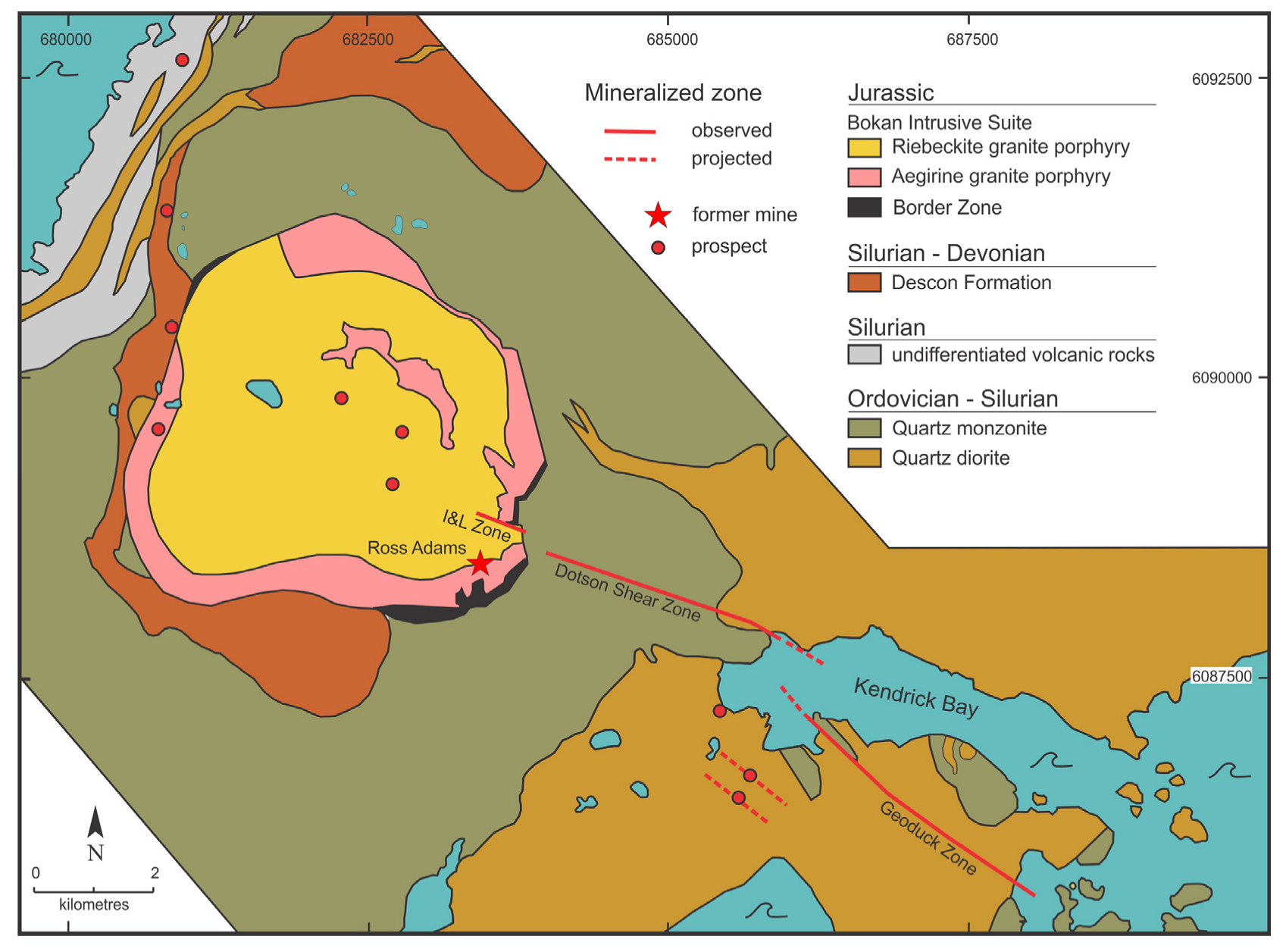Jurassic Uranium-Thorium Deposit of Peralkaline Granitic Rocks, Bokan Mountain, Prince of Wales Island, Southeastern Alaska
Abstract
1. Introduction
2. Geologic Setting and Petrography

3. History of Mining and Exploration
4. Mineral Prospects/Deposits
5. Geochronology
6. Analytical Methods
7. Geochemistry of the Pluton
8. Alteration/Metasomatism
9. Zircon Saturation Thermometry
10. Discussion
10.1. Emplacement
10.2. Petrogenesis
10.3. Origin of Mineralization
11. Conclusions
Supplementary Materials
Funding
Data Availability Statement
Acknowledgments
Conflicts of Interest
References
- Long, K.R.; Van Gosen, B.S.; Foley, N.K.; Cordier, D. The Principal Rare Earth Element Deposits of the United States—A Summary of Domestic Deposits and a Global Perspective; Scientific Investigations Report 2010-5220; U.S. Geological Survey: Reston, VA, USA, 2010; 96p.
- Verplanck, P.L.; Van Gosen, B.S.; Seal, R.R.; McCafferty, A.E. A Deposit Model for Carbonatite and Alkaline Intrusion-Related Rare Earth Element Deposits; Scientific Investigations Report 2010-5070-J; U.S. Geological Survey: Reston, VA, USA, 2014; 58p.
- Dostal, J. Rare metal deposits associated with alkaline/peralkaline igneous rocks. Rev. Econ. Geol. 2016, 18, 33–54. [Google Scholar]
- Cuney, M. Felsic magmatism and uranium deposits. Bull. Soc. Geol. Fr. 2014, 185, 75–92. [Google Scholar] [CrossRef]
- Cuney, M.; Kyser, K. Magmatic processes involved in uranium deposit formation. In Geology and Geochemistry of Uranium and Thorium Deposits; Cuney, M., Kyser, K., Eds.; Mineralogical Association of Canada, Short Course Series: Quebec City, QC, Canada, 2015; Volume 46, pp. 99–138. [Google Scholar]
- Boily, M.; William-Jones, A.E. The role of magmatic and hydrothermal processes in the chemical evolution of the Strange Lake plutonic complex, Quebec/Labrador. Contrib. Mineral. Petrol. 1994, 118, 33–47. [Google Scholar] [CrossRef]
- Salvi, S.; Williams-Jones, A.E. The role of hydrothermal processes in the granite-hosted Zr, Y, REE deposit at Strange Lake, Quebec/Labrador: Evidence from fluid inclusions. Geochim. Cosmochim. Acta 1990, 54, 2403–2418. [Google Scholar] [CrossRef]
- Salvi, S.; Williams-Jones, A.E. The role of hydrothermal processes in concentrating HFSE in the Strange Lake peralkaline complex, northeastern Canada. Geochim. Cosmochim. Acta 1996, 60, 1917–1932. [Google Scholar] [CrossRef]
- Linnen, R.L.; Cuney, M. Granite-related rare-element deposits and experimental constraints on Ta–Nb–W–Sn–Zr–Hf mineralization. In Rare-element Geochemistry and Mineral Deposits; Linnen, R.L., Samson, I.M., Eds.; Geological Association of Canada: St. John’s, NL, Canada, 2005; Volume 17, pp. 45–68. [Google Scholar]
- Salvi, S.; Williams-Jones, A.E. Alkaline granite-syenite deposits. In Rare-element Geochemistry and Mineral Deposits; Linnen, R.L., Samson, I.M., Eds.; Geological Association of Canada: St. John’s, NL, Canada, 2005; Volume 17, pp. 315–341. [Google Scholar]
- Gray, T.R.; Hanley, J.J.; Dostal, J.; Guillong, M. Magmatic enrichment of uranium, thorium and rare earth elements in late Paleozoic rhyolites of southern New Brunswick, Canada: Evidence from silicate melt inclusions. Econ. Geol. 2010, 106, 127–143. [Google Scholar] [CrossRef]
- Dostal, J. Rare Earth Element Deposits of Alkaline Igneous Rocks. Resources 2017, 6, 34. [Google Scholar] [CrossRef]
- Dostal, J.; Gerel, O. Rare Earth Element Deposits in Mongolia. Minerals 2023, 13, 129. [Google Scholar] [CrossRef]
- Bowden, P. The geochemistry and mineralization of alkaline ring complexes in Africa (A review). J. Afr. Earth Sci. 1985, 3, 17–39. [Google Scholar] [CrossRef]
- Bowden, P.; Black, R.; Martin, R.F.; Ike, E.C.; Kinnaird, J.A.; Batchelor, R.A. Niger-Nigerian alkaline ring complexes: A classic example of African Phanerozoic anorogenic mid-plate magmatism. Geol. Soc. Spec. Publ. 1987, 30, 357–379. [Google Scholar] [CrossRef]
- Richardson, D.G.; Birkett, T.C. Peralkaline rock associated rare metals. In The Geology of North America; Eckstrand, O.R., Sinclair, W.D., Thorpe, R.I., Eds.; Geological Society of America: Boulder, CO, USA, 1996; Volume P-1, pp. 523–540. [Google Scholar]
- Bonin, B. A-type granites and related rocks: Evolution of a concept, problems and prospects. Lithos 2007, 97, 1–29. [Google Scholar] [CrossRef]
- Dostal, J.; Kontak, D.J.; Hanley, J.; Owen, V. Geological Investigation of Rare Earth Element and Uranium Deposits of the Bokan Mountain Complex, Prince of Wales Island, southeastern Alaska; U.S. Geological Survey Mineral Resources External Research Program—Report GO9PA00039; U.S. Geological Survey: Reston, VA, USA, 2011; 122p.
- Dostal, J.; Kontak, D.J.; Karl, S.M. The Early Jurassic Bokan Mountain peralkaline granitic complex (southeastern Alaska): Geochemistry, petrogenesis and rare-metal mineralization. Lithos 2014, 202–203, 395–412. [Google Scholar] [CrossRef]
- Dostal, J.; Shellnutt, J.G. Origin of peralkaline granites of the Jurassic Bokan Mountain complex (southeastern Alaska) hosting rare metal mineralization. Int. Geol. Rev. 2016, 58, 1–13. [Google Scholar] [CrossRef]
- Colpron, M.; Nelson, J.L.; Murphy, D.C. Northern Cordilleran terranes and their interactions through time. GSA Today 2007, 17, 4–10. [Google Scholar]
- Colpron, M.; Nelson, J.L. A Palaeozoic Northwest Passage: Incursion of Caledonian, Baltican and Siberian terranes into eastern Panthalassa, and the early evolution of the North American Cordillera. In Earth Accretionary Systems in Space and Time; Cawood, P.A., Kröner, A., Eds.; Geological Society of London: London, UK, 2009; Volume 318, pp. 273–307. [Google Scholar]
- Colpron, M.; Nelson, J.L. (Eds.) Paleozoic Evolution and Metallogeny of Pericratonic Terranes at the Ancient Pacific Margin of North America, Canadian and Alaskan Cordillera; Geological Association of Canada: St. John’s, NL, Canada, 2006; Volume 45, 523p. [Google Scholar]
- Nelson, J.L.; Diakow, J.B.; Mahoney, J.B.; van Staal, C.; Pecha, M.; Angen, J.; Gehrels, G.; Lau, T. North Coast project: Tectonics and metallogeny of the Alexander terrane, and Cretaceous sinistral shearing of the western Coast belt. B.C. Minist. Energy Mines Pap. 2012, 1, 157–180. [Google Scholar]
- Dostal, J.; Karl, S.M.; Keppie, J.D.; Kontak, D.J.; Shellnutt, J.G. Bokan Mountain peralkaline granitic complex, Alexander terrane (southeastern Alaska): Evidence for Early Jurassic rifting prior to accretion with North America. Can. J. Earth Sci. 2013, 50, 678–691. [Google Scholar] [CrossRef]
- Gehrels, G.E.; Saleeby, J.B. Geology of southern Prince of Wales Island, southeastern Alaska. Geol. Soc. Am. Bull. 1987, 98, 123–137. [Google Scholar] [CrossRef]
- Karl, S.M.; Barker, J.C.; Dostal, J. Structural controls on emplacement of Early Jurassic peralkaline granite and rare earth mineralization at Bokan Mountain, southeast Alaska. Geol. Soc. Am. Abstr. Programs 2014, 46, 782. [Google Scholar]
- Barker, J.C.; Van Gosen, B.S. Alaska’s rare earth deposit and resource potential. Min. Eng. 2012, 64, 20–32. [Google Scholar]
- MacKevett, E.M., Jr. Geology and Ore Deposits of the Bokan Mountain Uranium-Thorium Area, Southeastern Alaska; U.S. Goverment Publishing Office: Washington, DC, USA, 1963; Volume 1154, 125p.
- Gehrels, G.E. Geologic Map of the Southern Prince of Wales Island, Southeastern Alaska; Map 1-2169, Scale 1:63,000; U.S. Geological Survey: Reston, VA, USA, 1992.
- Thompson, T.B.; Pierson, J.R.; Lyttle, T. Petrology and petrogenesis of the Bokan granite complex, southeastern Alaska. Geol. Soc. Am. Bull. 1982, 93, 898–908. [Google Scholar] [CrossRef]
- Philpotts, J.A.; Taylor, C.D.; Tatsumoto, M.; Belkin, H.E. Petrogenesis of Late-Stage Granites and Y-REE-Zr-Nb-Enriched vein Dikes of the Bokan Mountain Stock, Prince of Wales Island, Southeastern Alaska; Open File Report 98-459; U.S. Geological Survey: Reston, VA, USA, 1998; 71p.
- Thompson, T.B. Geology and uranium-thorium mineral deposits of the Bokan Mountain granite complex, southeastern Alaska. Ore Geol. Rev. 1988, 3, 193–210. [Google Scholar] [CrossRef]
- Thompson, T.B. Uranium, Thorium, and Rare Metal Deposits of Alaska. Econ. Geol. Monogr. 1997, 9, 460–482. [Google Scholar]
- Staatz, M.H. I&L uranium and thorium vein system, Bokan Mountain, southern Alaska. Econ. Geol. 1978, 73, 512–523. [Google Scholar]
- Stephens, F.H. The Kendrick Bay project. West. Min. 1971, 44, 151–158. [Google Scholar]
- Keyser, H.J.; McKenney, J. Geological Report on the Bokan Mountain Property, Prince of Wales Island, Alaska; NI 43-101 Report; Landmark Minerals Inc.: Toronto, ON, Canada, 2007; 48p. [Google Scholar]
- Warner, J.D.; Barker, J.C. Columbium and Rare Earth-Bearing Deposits at Bokan Mountain, Southeast Alaska; Open-File Report 33-89; United States Bureau of Mines: Washington, DC, USA, 1989; 196p.
- Bentzen, E.H.; Ghaffari, H.; Galbraith, L.; Hammen, R.F.; Robinson, R.J.; Hafez, S.A.; Annavarapu, S. Bokan Mountain Rare Earth Element Project near Ketchikan, Alaska; Preliminary Economic Assessment—NI 43-101; Tetra Tech.: Vancouver, BC, Canada, 2013; 227p. [Google Scholar]
- Taylor, C.D.; Aleinikoff, J.N.; Holm-Denoma, C.S.; Neymark, L.A.; Bala, S.A.; Pascarelli, S.E.; Piller, R.M.; Karl, S.M.; Van Gosen, B.S.; Morgan, L.E.; et al. New geochronologic constraints on the formation and hydrothermal enrichment of the Bokan Mountain peralkaline igneous complex and associated HREE deposits, Southeastern Alaska, USA. Geol. Soc. Am. Abstr. Programs 2016, 48, 3. [Google Scholar]
- Lanphere, M.A.; MacKevett, E.M.; Stern, T.W. Potassium-argon and lead-alpha ages of plutonic rocks, Bokan Mountain area, Alaska. Science 1964, 145, 705–707. [Google Scholar] [CrossRef]
- Armstrong, R.L. Rb-Sr dating of the Bokan Mountain granite complex and its country rocks. Can. J. Earth Sci. 1985, 22, 1233–1236. [Google Scholar] [CrossRef]
- Armstrong, R.L. Rb-Sr dating of the Bokan Mountain granite complex and its country rocks: Reply. Can. J. Earth Sci. 1986, 23, 744–745. [Google Scholar] [CrossRef]
- Eberlain, G.D.; Churkin, M.; Carter, C.; Berg, H.C.; Ovenshine, A.T. Geology of the Craig Quadrangle, Alaska; Open-File Report 83-91; U.S. Geological Survey: Reston, VA, USA, 1983; 50p.
- Thompson, T.B.; Lyttle, T.; Pierson, J.R. Genesis of the Bokan Mountain, Alaska, Uranium-Thorium Deposits; United States Department of Energy: Washington, DC, USA, 1980; 232p.
- De Saint-Andre, B.; Lancelot, J.R. Rb-Sr dating of the Bokan Mountain granite complex and its country rocks: Discussion. Can. J. Earth Sci. 1986, 23, 743–744. [Google Scholar] [CrossRef]
- Pollock, J.C.; Sylvester, P.J.; Barr, S.M. Lu-Hf zircon and Sm-Nd whole-rock isotope constraints on the extent of juvenile arc crust in Avalonia: Examples from Newfoundland and Nova Scotia, Canada. Can. J. Earth Sci. 2015, 52, 161–181. [Google Scholar] [CrossRef]
- De Paolo, D.J. Neodymium Isotope Geochemistry: An Introduction; Springer: New York, NY, USA, 1988; 187p. [Google Scholar]
- De la Roche, H.; Leterrier, J.; Grandclaude, P.; Marchal, M. A classification of volcanic and plutonic rocks using R1R2-diagram and major-element analyses—Its relationships with current nomenclature. Chem. Geol. 1980, 29, 183–210. [Google Scholar]
- Frost, B.R.; Barnes, C.G.; Collins, W.J.; Arculus, R.J.; Ellis, D.J.; Frost, C.D. A geochemical classification for granitic rocks. J. Petrol. 2001, 42, 2033–2048. [Google Scholar] [CrossRef]
- Dall’Agnol, R.; de Oliveira, D.C. Oxidized, magnetite-series, rapakivi-type granite of Carajas, Brazil: Implications for classification and petrogenesis of A-type granites. Lithos 2007, 93, 215–233. [Google Scholar] [CrossRef]
- Boynton, W.V. Cosmochemistry of the rare earth elements; meteorite studies. In Rare Earth Element Geochemistry; Henderson, P., Ed.; Elsevier: Amsterdam, The Netherlands, 1984; pp. 63–114. [Google Scholar]
- McDonough, W.F.; Sun, S.-S. The composition of the Earth. Chem. Geol. 1995, 120, 229–253. [Google Scholar] [CrossRef]
- Hilchie, L.; Russell, J.K.; Stanley, C.R. Unification of isocon and Pearce Element Ratio techniques in the quantification of material transfer. Econ. Geol. 2018, 113, 1603–1608. [Google Scholar] [CrossRef]
- Gervasoni, F.; Klemme, S.; Rocha-Junior, E.R.V.; Berndt, J. Zircon saturation in silicate melts: A new and improved model for aluminous and alkali melts. Contrib. Mineral. Petrol. 2016, 171, 12. [Google Scholar] [CrossRef]
- Watson, E.B.; Harrison, T.M. Zircon saturation revisited: Temperature and composition effects in a variety of crustal magma types. Earth Planet. Sci. Lett. 1983, 64, 295–304. [Google Scholar] [CrossRef]
- Boehnke, P.; Watson, E.B.; Trail, D.; Harrison, T.M.; Schmitt, A.K. Zircon saturation re-revisited. Chem. Geol. 2013, 351, 324–334. [Google Scholar] [CrossRef]
- Miller, C.F.; McDowell, S.M.; Mapes, R.W. Hot and cold granites? Implications of zircon saturation temperatures and preservation of inheritance. Geology 2003, 31, 529–532. [Google Scholar]
- Eby, G.N. Chemical subdivision of the A-type granitoids: Petrogenetic and tectonic implications. Geology 1992, 20, 641–644. [Google Scholar] [CrossRef]
- Whalen, J.B.; Currie, K.L.; Chappell, B.W. A-type granites: Geochemical characteristics, discrimination and petrogenesis. Contrib. Mineral. Petrol. 1987, 95, 407–419. [Google Scholar] [CrossRef]
- Dostal, J.; van Hengstum, T.R.; Shellnutt, J.G.; Hanley, J.J. Petrogenetic evolution of Late Paleozoic rhyolites of the Harvey Group, southwestern New Brunswick (Canada) hosting uranium mineralization. Contrib. Mineral. Petrol. 2016, 171, 1–20. [Google Scholar] [CrossRef]
- Dostal, J.; Capedri, S. Partition coefficients of uranium for some rock-forming minerals. Chem. Geol. 1975, 15, 285–294. [Google Scholar] [CrossRef]
- Dostal, J.; Dupuy, C.; Carron, J.P.; Le Guen Kerneizon, M.; Maury, R.C. Partition coefficients of trace elements: Application to volcanic rocks of St. Vincent, West Indies. Geochim. Cosmochim. Acta 1984, 47, 525–533. [Google Scholar] [CrossRef]
- Monecke, T.; Kempe, U.; Monecke, J.; Sala, M.; Wolf, D. Tetrad effect in rare earth element distribution patterns: A method of quantification with application to rock and mineral samples from granite-related rare metal deposits. Geochim. Cosmochim. Acta 2002, 66, 1185–1196. [Google Scholar] [CrossRef]
- Agangi, A.; Kamenetsky, V.S.; McPhie, J. The role of fluorine in the concentration and transport of lithophile trace elements in felsic magmas: Insights from the Gawler Range volcanics, South Australia. Chem. Geol. 2010, 273, 314–325. [Google Scholar] [CrossRef]
- Drinkwater, J.L.; Calzia, J.P. Geochemical Reconnaissance of Alkali Plutons on Prince of Wales Island, Southeastern Alaska; Alaska Department of Natural Resources, Geological and Geophysical Surveys; U.S. Geological Survey: Reston, VA, USA, 1994; pp. 173–184.
- Barker, J.C. Rare Earth Element- and Yttrium-Bearing Pegmatite Dikes near Dora Bay: Southern Prince of Wales Island; Open-File Rep. 19-90; United States Bureau of Mines: Washington, DC, USA, 1990; 41p.
- Eakins, G.R. Uranium investigations in southeastern Alaska. Alsk. Div. Geol. Geophys. Surv. Rep. 1975, 44, 59. [Google Scholar]
- Barker, J.C.; Mardock, C.L. Lithophile metal, REE-Y-Nb deposits on southern Prince of Wales Island, Alaska. In Process Mineralogy VIII; Carson, D.J.T., Vassiliou, A.H., Eds.; The Minerals, Metals and Materials Society: Pittsburgh, PA, USA, 1988; pp. 139–157. [Google Scholar]
- Bala, S.A.; Holm-Denoma, C.S.; Neymark, L.A.; Taylor, C.D.; Pietruszka, A.J.; Driscoll, R.L. U-Pb zircon ages and mineralogy of the Dora Bay intrusive complex and heavy REE-bearing pegmatite dikes. Geol. Soc. Am. Abstr. Programs 2014, 46, 782. [Google Scholar]
- Dostal, J.; Karl, S.M.; Friedman, R.; Mortensen, J.K.; Layer, P.W.; Ford, A.B.; Corney, R. Late Devonian syenitic intrusion from southeastern Alaska: Petrogenesis, tectonic implications, and rare metal metallogeny. Lithos 2021, 396–397, 106205. [Google Scholar] [CrossRef]
- McCafferty, A.E.; Stoeser, D.B.; Van Gosen, B.S. Geophysical interpretation of U, Th, and rare earth element mineralization of the Bokan Mountain peralkaline granite complex, Prince of Wales Island, southeast Alaska. Interpretation 2014, 2, SJ47–SJ63. [Google Scholar] [CrossRef]
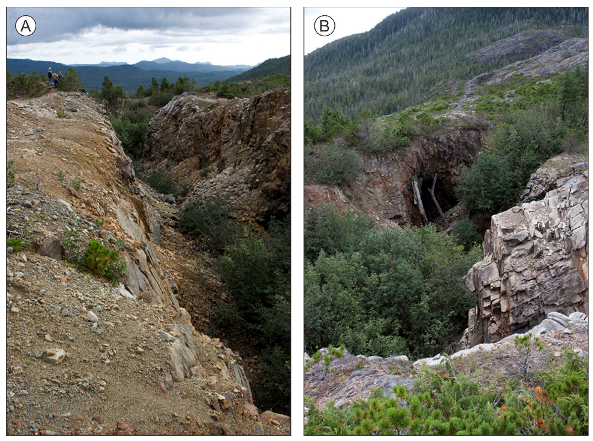
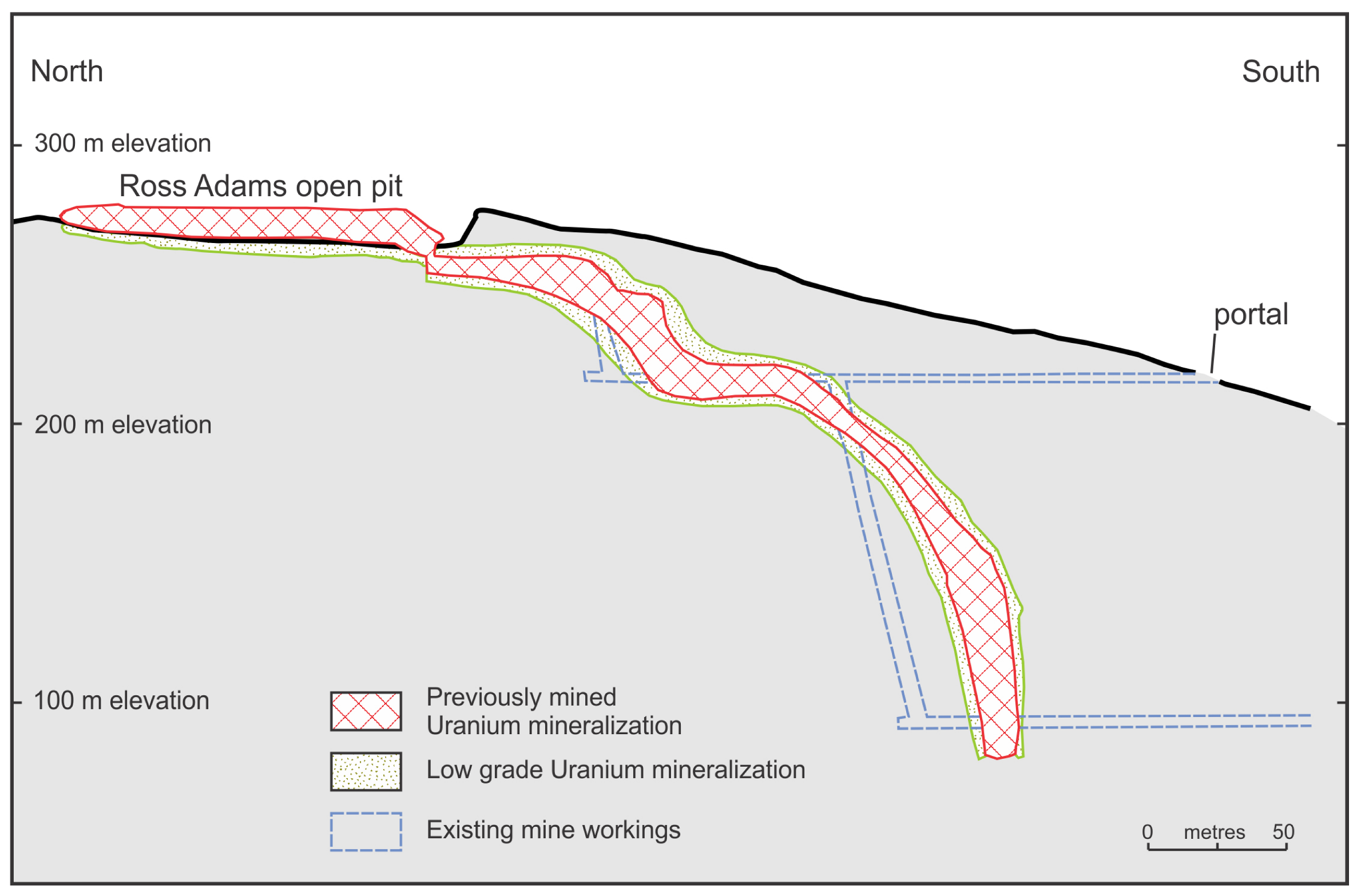
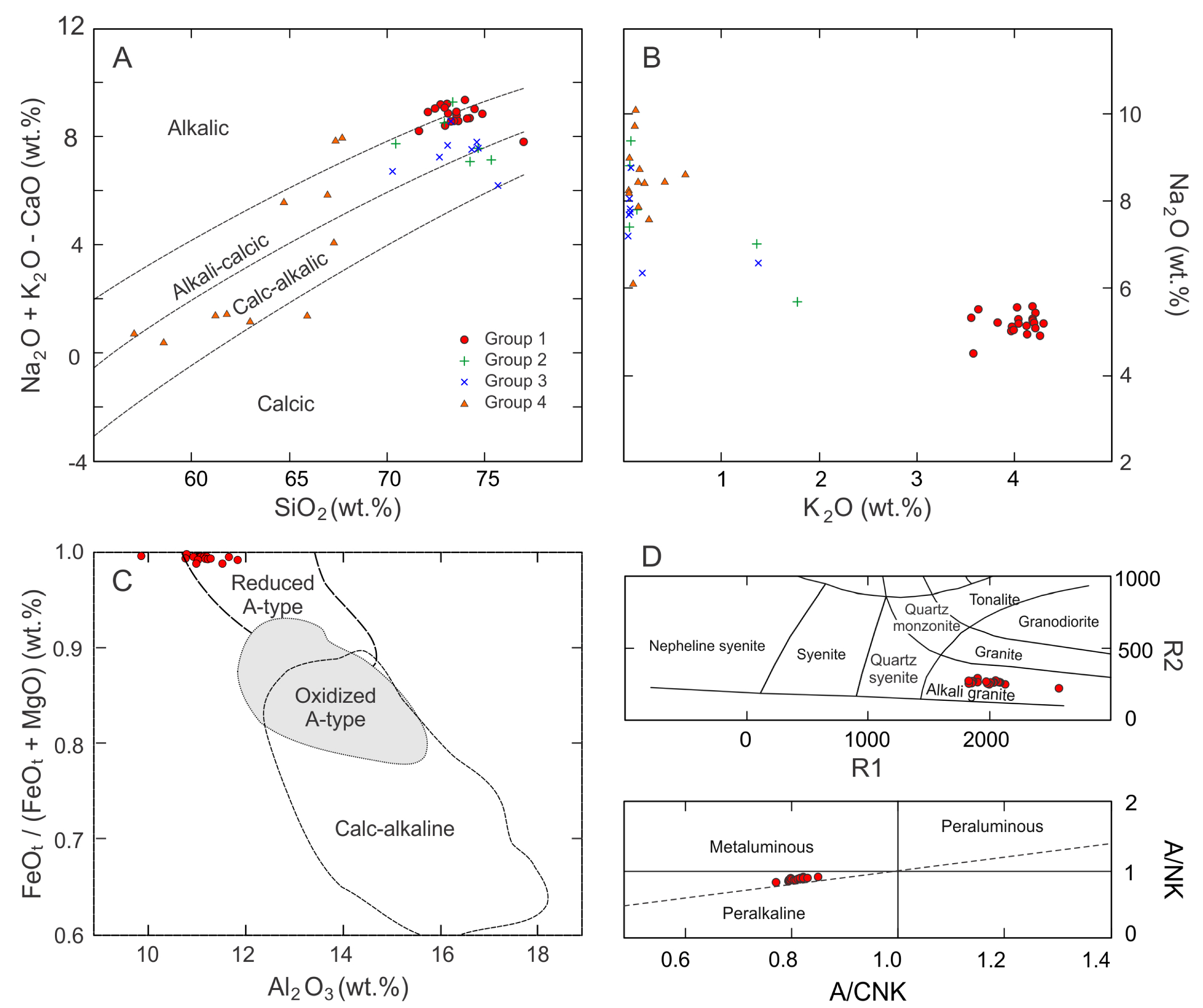
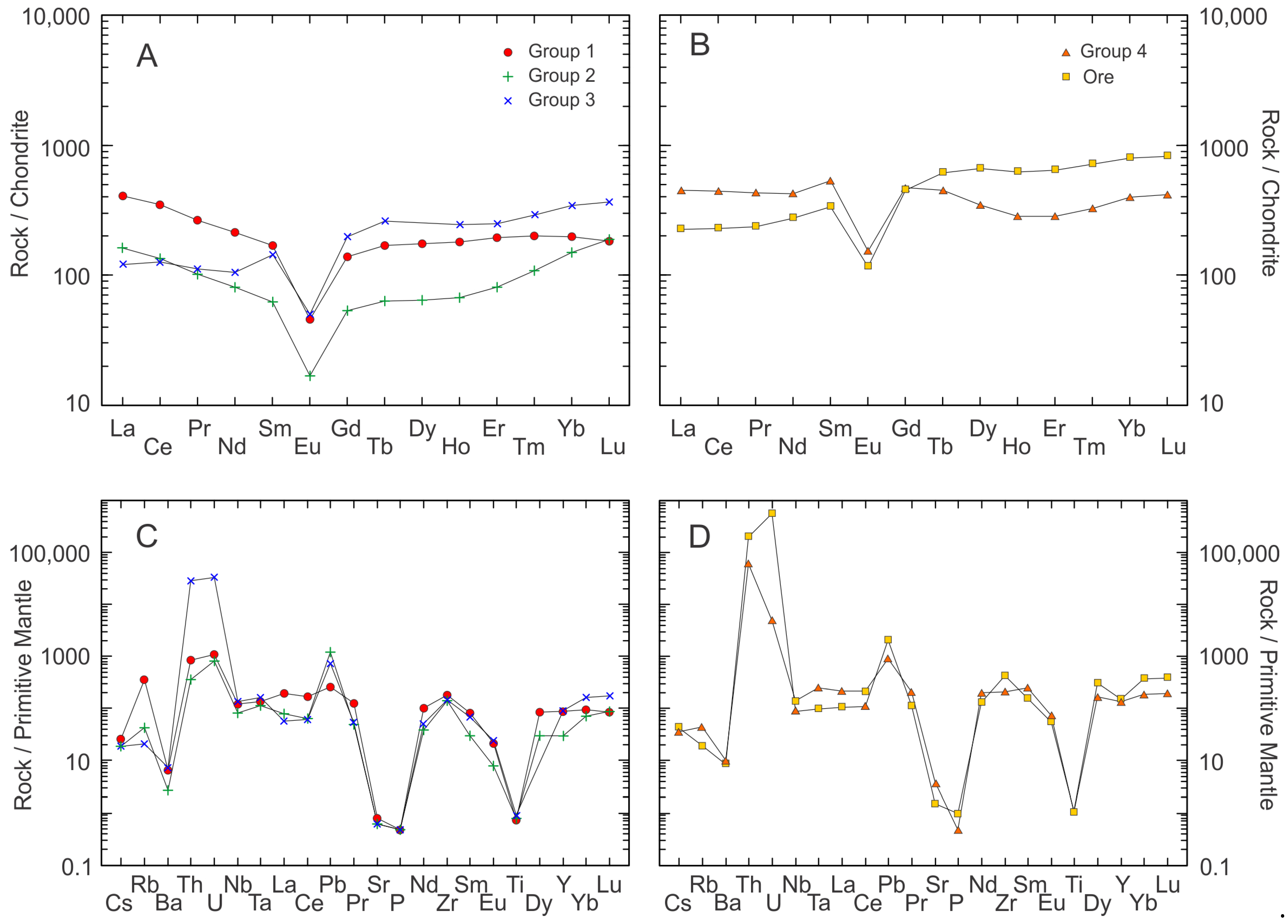


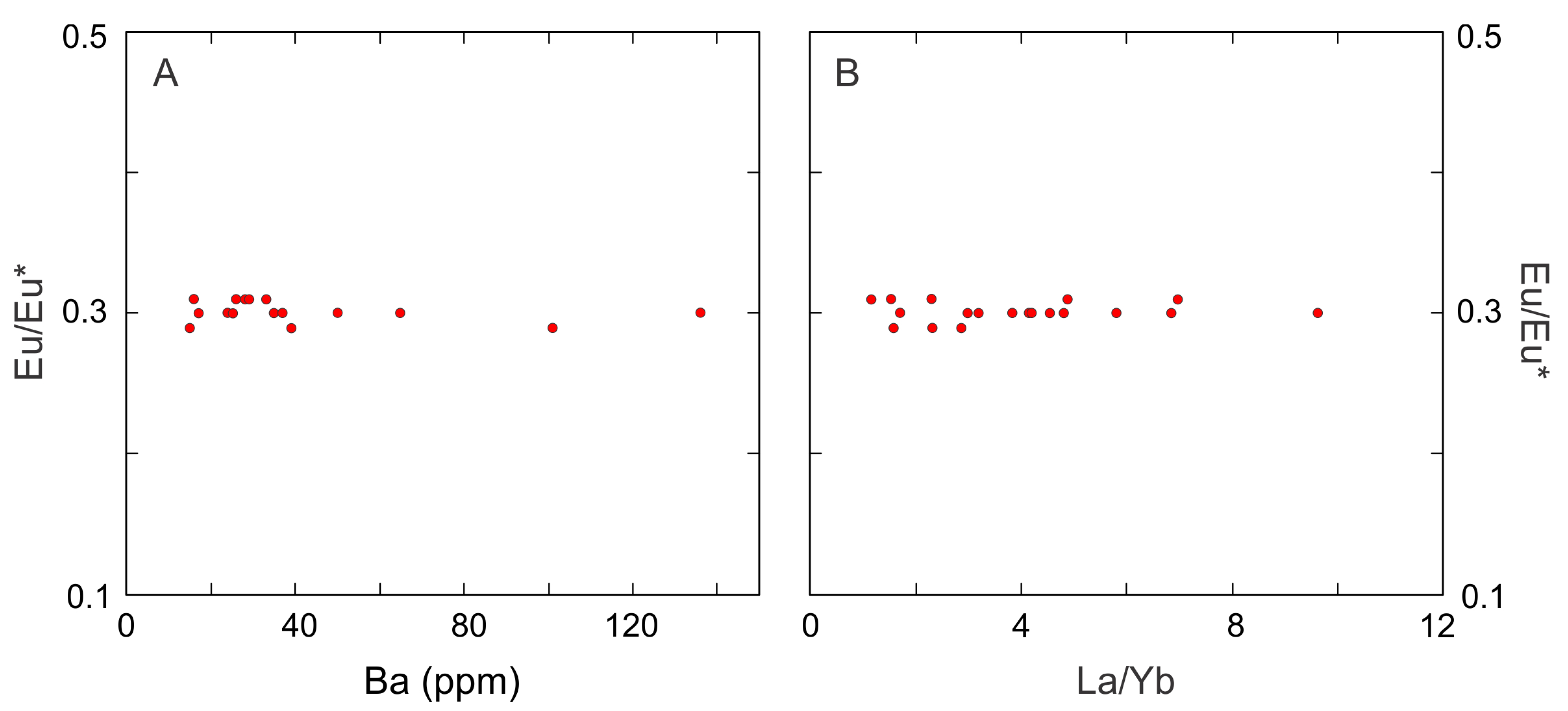
| Sample | Age (Ma) | Nd (ppm) | Sm (ppm) | 147Sm/144Nd | 143Nd/144Nd(m) | 2σ | 143Nd/144Nd(i) | ƐNd(t) | TDM (Ma) | |
|---|---|---|---|---|---|---|---|---|---|---|
| 757 | granite | 177 | 44.4 | 9.30 | 0.1267 | 0.512834 | 7 | 0.512687 | 5.4 | 395 |
| 758 | granite | 177 | 92.1 | 22.7 | 0.1491 | 0.512851 | 5 | 0.512678 | 5.2 | 485 |
| 777 | granite | 177 | 120 | 29.2 | 0.1472 | 0.512842 | 8 | 0.512672 | 5.1 | 491 |
| n | 20 | 7 | 8 | 12 | 3 | ||||
|---|---|---|---|---|---|---|---|---|---|
| (wt.%) | Group 1 | Group 2 | Group 3 | Group 4 | Ore | ||||
| aver | stdv | aver | stdv | aver | stdv | aver | stdv | ||
| SiO2 | 73.56 | 1.11 | 73.62 | 1.64 | 73.56 | 1.66 | 63.61 | 3.61 | 64.03 |
| TiO2 | 0.15 | 0.02 | 0.15 | 0.09 | 0.18 | 0.05 | 0.21 | 0.09 | 0.22 |
| Al2O3 | 10.98 | 0.35 | 10.39 | 2.32 | 1.37 | 0.26 | 12.93 | 1.44 | 12.37 |
| Fe2O3 | 4.46 | 0.51 | 6.01 | 2.67 | 4.94 | 0.70 | 4.33 | 2.13 | 7.34 |
| MnO | 0.08 | 0.04 | 0.12 | 0.08 | 0.12 | 0.07 | 0.14 | 0.09 | 0.29 |
| MgO | 0.03 | 0.01 | 0.01 | 0.01 | 0.03 | 0.02 | 0.15 | 0.11 | 0.17 |
| CaO | 0.38 | 0.09 | 0.32 | 0.12 | 0.29 | 0.10 | 6.13 | 4.15 | 0.39 |
| Na2O | 5.19 | 0.25 | 7.53 | 1.29 | 7.54 | 0.80 | 8.42 | 1.02 | 7.74 |
| K2O | 4.03 | 0.22 | 0.63 | 0.73 | 0.24 | 0.46 | 0.17 | 0.16 | 0.07 |
| P2O5 | 0.01 | 0.00 | 0.01 | 0.01 | 0.01 | 0 | 0.02 | ||
| LOI | 0.44 | 0.27 | 0.39 | 0.24 | 0.70 | 0.41 | 1.47 | 0.32 | 2.32 |
| Total | 99.9 | 99.19 | 98.97 | 97.56 | 94.96 | ||||
| (ppm) | |||||||||
| Be | 6.35 | 1.5 | 9.14 | 4.3 | 9.63 | 1.69 | 12.75 | 2.9 | |
| Zn | 300 | 108 | 517.1 | 415 | 270 | 119 | 268.3 | 199 | |
| Ga | 38.8 | 1.5 | 42.71 | 8.2 | 40.25 | 2.5 | 48.25 | 5.3 | |
| Rb | 217 | 29.7 | 29.0 | 34.2 | 12.5 | 27.0 | 26.67 | 22.9 | 11.63 |
| Sr | 15.7 | 9.1 | 12.86 | 10.5 | 12.38 | 9.21 | 76.92 | 31.6 | 29.67 |
| Y | 372.1 | 469 | 141.7 | 155.4 | 388.0 | 385 | 580.9 | 221 | 649.7 |
| Zr | 1898 | 1200 | 1534 | 943 | 1550 | 1278 | 2161 | 2005 | 4520 |
| Nb | 79.65 | 38.4 | 57.71 | 29.6 | 87.75 | 42.2 | 91.83 | 90.2 | 58.33 |
| Sn | 22.1 | 10.2 | 19.43 | 16.3 | 26.38 | 7.98 | 12.42 | 13.2 | |
| Cs | 0.54 | 0.23 | 0.40 | 0.20 | 0.40 | 0.20 | 0.75 | 0.60 | 0.90 |
| Ba | 44.40 | 33.7 | 19.43 | 16.3 | 48.25 | 36.5 | 66.58 | 130 | 56.10 |
| La | 126.3 | 49.2 | 56.84 | 58.5 | 37.46 | 29.0 | 138.2 | 160 | 69.37 |
| Ce | 280.9 | 115.3 | 122.1 | 125.6 | 101.9 | 83.6 | 357.2 | 336 | 182.7 |
| Pr | 32.44 | 13.2 | 14.07 | 15.0 | 13.69 | 12.4 | 52.26 | 44.4 | 28.7 |
| Nd | 127.8 | 54.1 | 54.27 | 58.2 | 63.34 | 63.9 | 250.6 | 208 | 163 |
| Sm | 32.92 | 15.1 | 13.51 | 14.8 | 28.18 | 32.3 | 103.1 | 92.4 | 64.5 |
| Eu | 3.38 | 1.71 | 1.38 | 1.57 | 3.69 | 4.16 | 11.15 | 9.59 | 8.47 |
| Gd | 35.95 | 21.1 | 15.34 | 18.5 | 50.93 | 60.4 | 120.6 | 96.2 | 115 |
| Tb | 8.04 | 5.99 | 3.3 | 3.99 | 12.41 | 14.1 | 21.26 | 14.9 | 28.9 |
| Dy | 56.31 | 49.7 | 22.47 | 26.0 | 84..68 | 91.6 | 111.2 | 69.7 | 210 |
| Ho | 12.92 | 12.9 | 5.26 | 5.52 | 17.56 | 17.7 | 20.19 | 10.9 | 44.00 |
| Er | 40.52 | 41.7 | 18.04 | 15.9 | 52.33 | 45.5 | 58.78 | 28.3 | 133.3 |
| Tm | 6.48 | 5.91 | 3.65 | 2.54 | 9.43 | 6.3 | 10.5 | 5.83 | 22.8 |
| Yb | 41.22 | 30.5 | 31.67 | 20.3 | 71.71 | 38.4 | 81.96 | 51.1 | 165.7 |
| Lu | 5.87 | 3.60 | 6.02 | 4.02 | 11.82 | 5.96 | 13.22 | 8.75 | 26.3 |
| Hf | 44.72 | 27.6 | 37.27 | 23.1 | 36.28 | 29.4 | 55.99 | 51.1 | 19.4 |
| Ta | 5.04 | 2.00 | 4.53 | 2.14 | 6.08 | 3.03 | 9.28 | 10.1 | 3.57 |
| Pb | 39.33 | 41.8 | 198.1 | 464 | 109.5 | 133 | 137.8 | 203 | 313 |
| Th | 67.60 | 61.2 | 29.79 | 20.0 | 2330 | 2838 | 4827 | 5324 | 15,900 |
| U | 21.90 | 9.94 | 17.51 | 7.95 | 673.7 | 663.4 | 97.87 | 68.0 | 11,153 |
Disclaimer/Publisher’s Note: The statements, opinions and data contained in all publications are solely those of the individual author(s) and contributor(s) and not of MDPI and/or the editor(s). MDPI and/or the editor(s) disclaim responsibility for any injury to people or property resulting from any ideas, methods, instructions or products referred to in the content. |
© 2023 by the author. Licensee MDPI, Basel, Switzerland. This article is an open access article distributed under the terms and conditions of the Creative Commons Attribution (CC BY) license (https://creativecommons.org/licenses/by/4.0/).
Share and Cite
Dostal, J. Jurassic Uranium-Thorium Deposit of Peralkaline Granitic Rocks, Bokan Mountain, Prince of Wales Island, Southeastern Alaska. Minerals 2023, 13, 1032. https://doi.org/10.3390/min13081032
Dostal J. Jurassic Uranium-Thorium Deposit of Peralkaline Granitic Rocks, Bokan Mountain, Prince of Wales Island, Southeastern Alaska. Minerals. 2023; 13(8):1032. https://doi.org/10.3390/min13081032
Chicago/Turabian StyleDostal, Jaroslav. 2023. "Jurassic Uranium-Thorium Deposit of Peralkaline Granitic Rocks, Bokan Mountain, Prince of Wales Island, Southeastern Alaska" Minerals 13, no. 8: 1032. https://doi.org/10.3390/min13081032
APA StyleDostal, J. (2023). Jurassic Uranium-Thorium Deposit of Peralkaline Granitic Rocks, Bokan Mountain, Prince of Wales Island, Southeastern Alaska. Minerals, 13(8), 1032. https://doi.org/10.3390/min13081032





